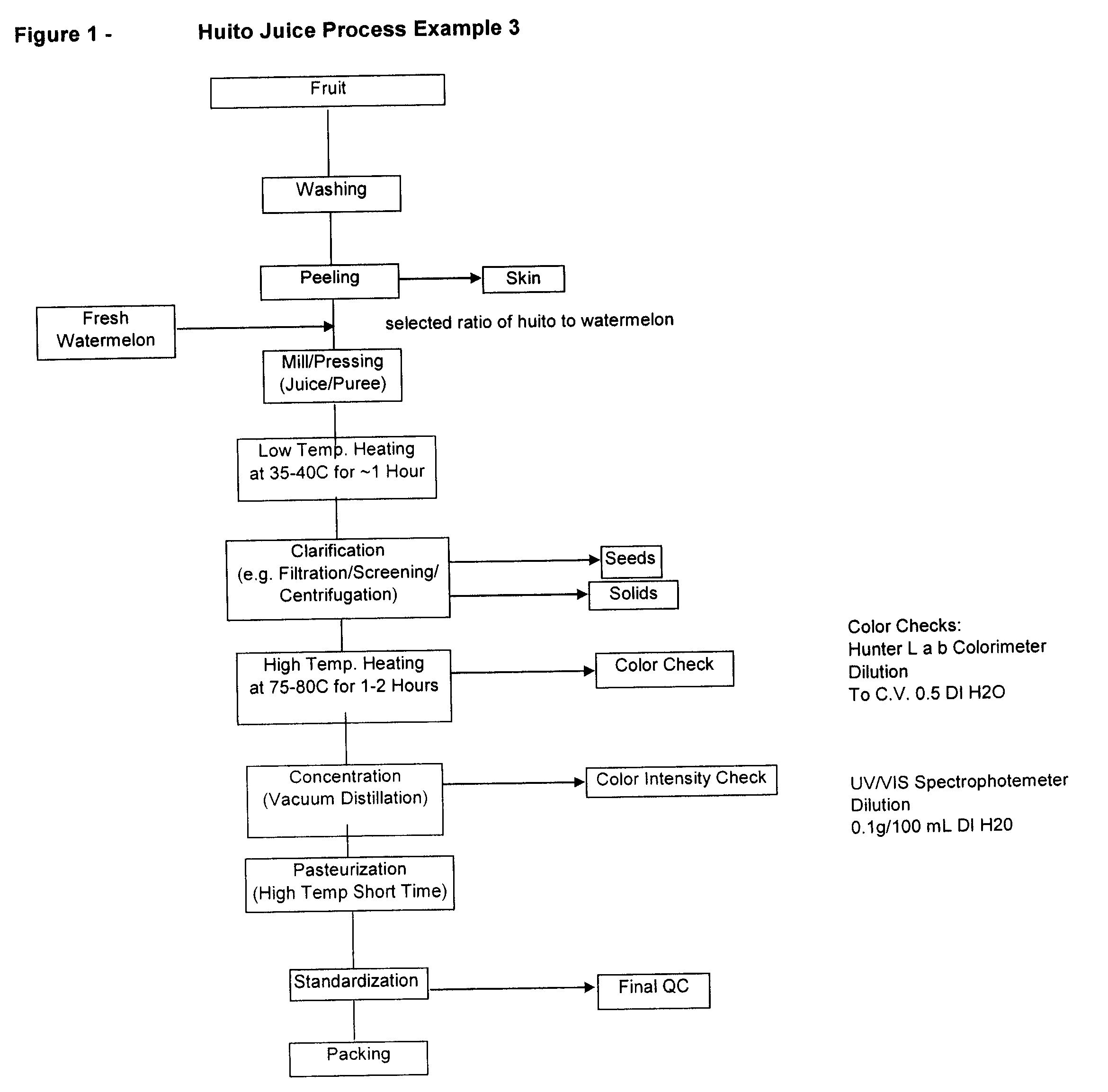Stable Natural Color Process, Products and Use Thereof
a natural color and stable technology, applied in the direction of application, dyeing process, transportation and packaging, etc., to achieve the effect of achieving good color stability, good color stability, and good color stability
- Summary
- Abstract
- Description
- Claims
- Application Information
AI Technical Summary
Benefits of technology
Problems solved by technology
Method used
Image
Examples
example # 1
EXAMPLE #1
[0036]Several frozen and thawed Huito fruits were peeled and cut into small pieces. One part of fruit, 116.0 g, was mixed with two parts of de-ionized water, 232.0 g, and blended using a high speed Laboratory Blender (Waring® Commercial) for 2 periods of 40 seconds each. Then the blended fruit puree was filtered through a No. 4 Whatman filter paper, and the filtered liquid was collected. Beta-glucosidase (Enzyme Development Corp.) was added to the filtrate at a quantity of 0.10 g per 60.0 g solution.
[0037]To five grams of the solution above in a test tube (25 ml), five grams of liquid or powder materials from fruits, vegetable, milk, soy, and meat were added in the test tube, and mixed well. Samples were left to stand at room temperature for 16 hours, and then heated to 80° C. for 0.5-2.5 hours until the color was stable. Samples were clarified by filtration, if necessary, to remove insoluble material.
[0038]Color changes of co-processed materials before and after incubatio...
example # 2
EXAMPLE #2
[0039]Peeled and diced Huito fruit, 150.0 g were mixed with fresh diced watermelon, 1200.0 g, and pureed for one minute in a blender. Then the puree / juice was heated in a water bath at 40° C. for one hour. The puree / juice was then centrifuged at 2800 rpm for 20 min, and the supernatant was filtered through fluted filter paper. Next the filtrate was heated in a hot-water bath (80° C.) for 1.5 hours; after which the solution was blue in color. The blue solution then was concentrated in a Rotavapor (Buchi, Switzerland) at 40 mmHg pressure and 50° C. and 100 rpm rotation. The final sample that was obtained after 7.5× concentration had an apparent Brix of 75-78, and a maximum absorption of 0.13366 at 595.79 nm in a spectrometer (Perkin Elmer UV / VIS Spectrometer, Lambda 20, USA) after 100× dilution with de-ionized water.
example # 3
EXAMPLE #3
[0040]The blue colored product was prepared from 2,931 g of peeled Huito fruits with fresh watermelon, 11,305 g, and pureed one minute in a blender. The puree / juice was stirred in a 20 L kettle at about 37-40 degree ° C. for one hour after which it was filtered to remove solids by passage through a number #20 mesh size screen and a 5 μm filter at a pump speed of 1.0 liter per minute. The filtrate was returned to the cleaned kettle and heated to about 75-80° C. for 1.5 hours with vigorous stirring. The resultant blue solution was concentrated in a Rotavapor (Buchi, Switzerland) at 40 mmHg pressure and 50° C. and 100 rpm rotation. The final sample had an apparent concentration of 63.25 Brix, and a maximum absorption of 0.57124 at 591.76 nm wavelength in a spectrometer (Perkin Elmer UV / VIS Spectrometer, Lambda 20, USA) after 1000× dilution with de-ionized water. The process is diagramed in FIG. 1.
PUM
| Property | Measurement | Unit |
|---|---|---|
| temperature | aaaaa | aaaaa |
| temperature | aaaaa | aaaaa |
| temperature | aaaaa | aaaaa |
Abstract
Description
Claims
Application Information
 Login to View More
Login to View More - R&D
- Intellectual Property
- Life Sciences
- Materials
- Tech Scout
- Unparalleled Data Quality
- Higher Quality Content
- 60% Fewer Hallucinations
Browse by: Latest US Patents, China's latest patents, Technical Efficacy Thesaurus, Application Domain, Technology Topic, Popular Technical Reports.
© 2025 PatSnap. All rights reserved.Legal|Privacy policy|Modern Slavery Act Transparency Statement|Sitemap|About US| Contact US: help@patsnap.com


